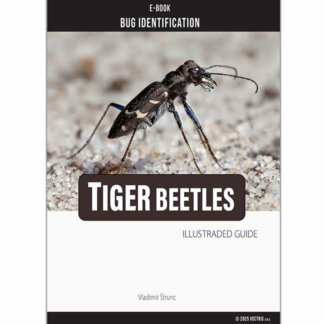Unique pictorial atlases for identifying Beetles. The life cycle of tiger beetles involves four distinct stages: egg, larva, pupa, and adult. Here’s an overview of each stage:
Beetles
Egg Stage
We recommend:
jeweled beetles, ground beetles, longhorn beetles, goliath beetle, stag beetle, carpet beetles
Tiger Beetle life cycle
Laying: Female tiger beetles lay their eggs singly in burrows made by their ovipositor in the soil. The oviposition site is often covered with soil to deter predators.
Development: Eggs develop and hatch within these burrows.
Larval Stage
Characteristics: Tiger beetle larvae are predatory and live in vertical burrows they dig and enlarge as they grow. They have a large, flattened head and curved, hinged mandibles.
Behavior: Larvae wait at the burrow entrance to ambush prey, using their sickle-shaped jaws to capture and pull it down into the burrow.
Threats: They face threats from predators like Hister beetles, birds, and ants, and are parasitized by bombyliids and wasps.
Duration: The larval period can last up to four years depending on the species and food availability.
Unique pictorial atlases for identifying Beetles:
(2020) Tiger Beetles of the World, Cicindelidae, Illustrated guide to the genera
Books about Beetles
Unique pictorial atlases for identifying Beetles:
(2020) Tiger Beetles of the World, Cicindelidae, Illustrated guide to the genera
(2023) Tiger Beetles of Africa, Cicindelidae, Geographical guide to the family Cicindelidae
(2024) Tiger Beetles of Orient, Cicindelidae, Geographical guide to the family Cicindelidae
(2022) Ground Beetles of Africa, Afrotropical Region
(2022) Jewel Beetles of the World, Buprestidae, Illustrated guide to the Superfamily Buprestoidea
(2008) The Prionids of the World, Prioninae, Illustrated catalogue of the Beetles
(2010) The Prionids of the Neotropical region, Prioninae, Illustrated catalogue of the Beetles
Pupal Stage
Formation: The mature larva forms a pupal cell within the burrow, sealing the entrance with soil before pupation.
Duration: Pupation typically lasts three or more weeks.
Transformation: During this stage, the larva transforms into an adult without feeding.
Tiger Beetle life cycle
Adult Stage
Emergence: After pupation, the adult emerges from the burrow but remains soft and light-colored for a few days until its exoskeleton hardens.
Mating: Adults mate soon after emergence, with males sometimes exhibiting mate-guarding behavior to prevent immediate re-mating.
Predation and Diet: Adults are known for their speed and agility, feeding on various invertebrates. They are also preyed upon by dragonflies, robber flies, and other predators.
Lifespan: Adults typically live for one to two years. Tiger Beetle life cycle












